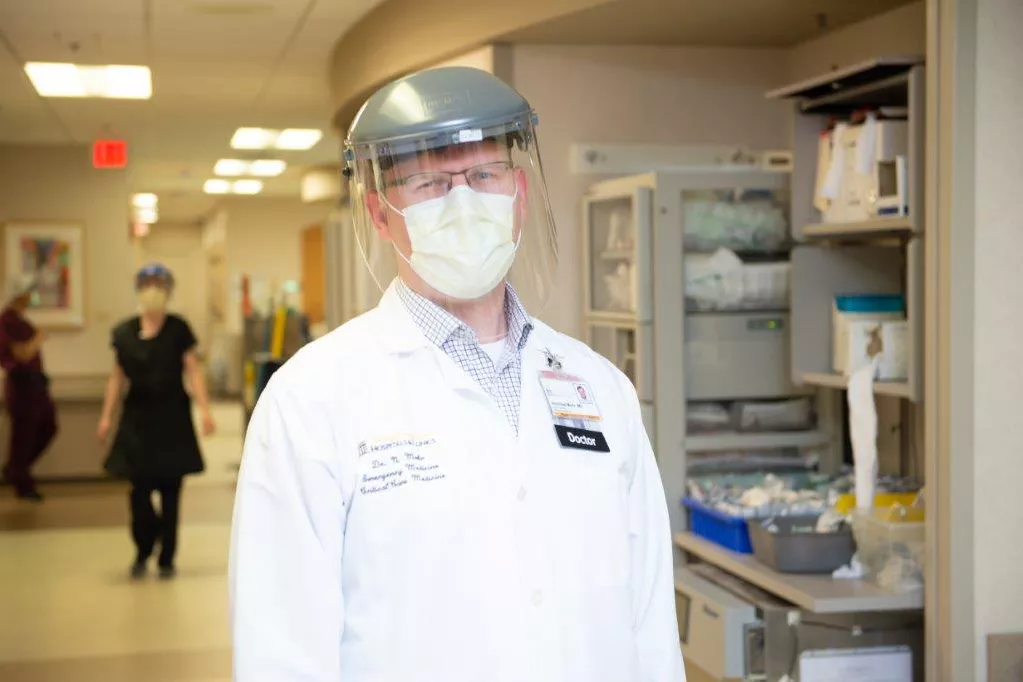One ED doctor’s quest: Understanding what keeps health care workers safe

Emergency medicine physician Nick Mohr, MD, MS, treated the first UI Health Care patient diagnosed with COVID-19 in the intensive care unit. Soon after, he saw a way to contribute to research that could help him and his colleagues going forward.
“All of us who do this kind of work recognize that there is a risk,” says Mohr, who joined UI Health Care nearly nine years ago. “What we’re trying to do in real-time is come up with new solutions today that can change the way we take care of people tomorrow and keep us all safer and healthier.”
His quest is now the goal of a nationwide study that is funded by a $3.7 million grant from the Centers for Disease Control and Prevention (CDC).
Called the COVID-19 Evaluation of Risk in Emergency Departments (COVERED) Project, the study is a collaborative effort between the University of Iowa Carver College of Medicine and the David Geffen School of Medicine at UCLA. Mohr is co-principal investigator of the study with Dave Talan, MD, professor of emergency medicine and infectious diseases at the David Geffen School of Medicine at UCLA and at the University of Iowa. The University of Iowa serves as the national Data Coordinating Center for the study, with UCLA serving as the Clinical Coordinating Center.
“We went from brainstorming about the need for this study to writing a grant application, securing funding, and enrolling participating institutions in the COVERED network in just three weeks,” he says. “It was all done in record time because the CDC deemed this information critical to protecting health care workers and the health care system, not only in this pandemic, but in future epidemics and pandemics.”
Tracking the data
Mohr, vice chair of research in the Department of Emergency Medicine and an associate professor of emergency medicine, anesthesia and epidemiology, is a physician-scientist at heart, fascinated with the problem-solving aspects of medicine.
“When COVID-19 patients started to arrive at UI Hospitals & Clinics, we were already well prepared because we have trained for years on how to deal with the emergence of highly transmissible infections, and how to treat patients with these types of diseases,” he explains. “This situation put our knowledge, skills, and best practices to the test.”
The COVERED project, a 12-week study that will ultimately enroll 1,600 faculty and staff in 20 academic healthcare institutions across the country, will document the use of personal protective equipment (PPE) such as face masks, face shields, gowns, and gloves. Participants include physicians, nurses, and emergency department staff, such as clerks, social workers, and case managers.
Participants will also be broken into two categories—those that have inserted a tube into the mouth and airway of a confirmed COVID-19 patient so a ventilator can help them breathe and those who haven’t. The segmentation will help researchers see how these and other aerosol-producing procedures increase the risk for virus transmission.
All study participants will undergo screenings and biweekly blood tests to evaluate for COVID-19 exposure, and questionnaires will be completed weekly. The tests also will determine if COVID-19 illness is identified without the health care provider showing any outward symptoms. In addition, participants also will be asked to track COVID-19 transmission among any family members.
A critical time
Once the full data is collected by this summer, Mohr anticipates it will take another six to nine months to interpret and then publish the results. And while it may take almost a year to determine what works best, the study timeframe is incredibly short when compared to traditional medical studies.
“You don’t get many opportunities to know the risk of transmission during a worldwide pandemic,” says Mohr. “It is critical to identify what reduces the risk of infection transmission among health care workers so that we can protect ourselves and continue to take care of the people in our communities who need our help.”
Learn more about the COVERED study | Get the latest on COVID-19 | Media Contacts